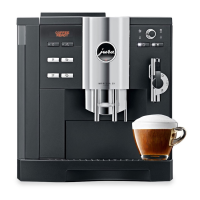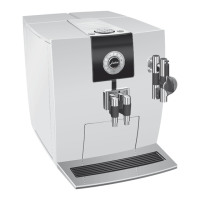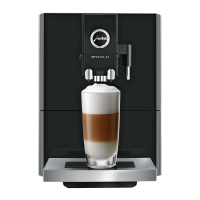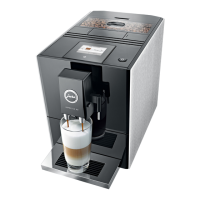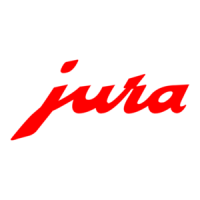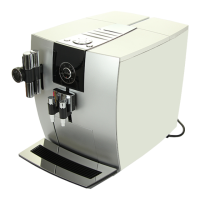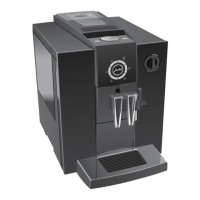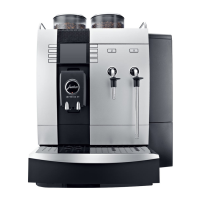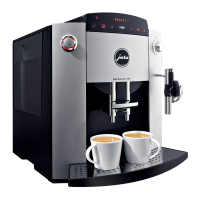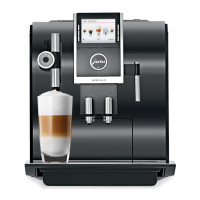
Do you have a question about the Jura IMPRESSA Z9 One Touch TFT and is the answer not in the manual?
| Model | IMPRESSA Z9 One Touch TFT |
|---|---|
| Display | TFT Color Display |
| Bean Container Capacity | 280 grams |
| Coffee Grounds Container Capacity | 16 servings |
| Pump Pressure | 15 bar |
| Voltage | 220-240 V |
| Power | 1450 W |
| Programmable | Yes |
| Frequency | 50/60 Hz |
| Coffee Types | Espresso, Coffee, Cappuccino, Latte Macchiato |
Essential guidelines for safe operation to prevent injury or hazards during use.
Defines proper appliance application and critical actions to avoid for warranty validity.
Safety instructions for the power cord to prevent electrical hazards and entanglement.
Important cautions and notices regarding appliance operation, handling, and potential risks.
Labeled diagram identifying all external parts and their numbers on the coffee machine.
Identifies buttons, rotary switch, and display located on the top surface of the machine.
Details the main display and multi-function buttons on the front of the coffee machine.
Steps for placing the machine, filling the bean container, and initial setup.
Guide for initial machine operation and installing/activating the water filter cartridge.
Method to test water hardness for optimal machine performance and maintenance planning.
Setting coffee grind fineness for desired coffee consistency.
Instructions for filling the water tank with fresh, cold water.
Connecting the milk system for frothing and preparing milk-based drinks.
Overview of different methods for brewing coffee and preparing milk-based drinks.
Steps for preparing various coffee types, including espresso, coffee, and special coffees.
Instructions for making latte macchiato, cappuccino, and preparing warm milk or milk foam.
Guide for brewing coffee using pre-ground coffee instead of beans via the filler funnel.
How to permanently adjust water and milk volumes for customized cup sizes.
Instructions for dispensing hot water at selectable temperatures.
Steps for powering on the machine and initiating the startup rinse cycle.
Essential daily cleaning and upkeep for machine hygiene and optimal performance.
Steps to properly turn off the machine, including rinsing spouts.
Viewing the status of maintenance programs like cleaning and descaling.
Adjusting temperature, strength, and volume for various coffee drinks and milk preparations.
Option to change the machine's display language to suit user preference.
Configuring power-saving settings to reduce energy consumption.
Setting the timer for the machine to automatically power down after inactivity.
Customizing display brightness, color schemes, and units for water volume measurement.
Setting the machine based on local water hardness for optimal performance and descaling frequency.
Accessing data on product preparation counts, maintenance history, and software version.
Customizing the main display to include frequently used beverage options.
Changing the names of displayed coffee products for personalization.
Resetting various machine settings to their original factory defaults.
Configuring switch-on rinse and milk system rinse modes (Manual/Automatic).
Overview of available automated maintenance tasks like rinsing, cleaning, and descaling.
Procedure for manually rinsing the coffee system to maintain cleanliness.
Steps for rinsing the milk system after preparing milk-based drinks.
Detailed daily cleaning, dismantling, and rinsing steps for the milk frothing system.
Procedure for taking apart and thoroughly cleaning the milk frother components.
Procedures for installing and activating a new water filter cartridge.
Procedure for replacing the water filter cartridge when it reaches its operational limit.
Steps for performing a deep clean of the coffee machine using cleaning tablets.
Instructions for removing limescale buildup to maintain machine efficiency and longevity.
Instructions for cleaning the coffee bean container to ensure optimal coffee flavor.
Procedure to remove limescale deposits from the water tank for correct machine function.
Explanations for messages indicating low water, full containers, or missing components.
Messages signaling the need for cleaning, descaling, or filter replacement.
Solutions for problems related to milk foam, coffee drips, or blockages during preparation.
Guidance for resolving specific error codes, machine noises, and temperature-related problems.
Procedures for safely draining internal systems before moving the machine to prevent frost damage.
Guidelines for responsible disposal of the old coffee machine at the end of its life.
Key technical details including voltage, power, dimensions, capacity, and compliance standards.
Contact information for JURA support in USA and Canada, plus distributor details.
Notices regarding potential machine updates and copyright restrictions for the manual.
